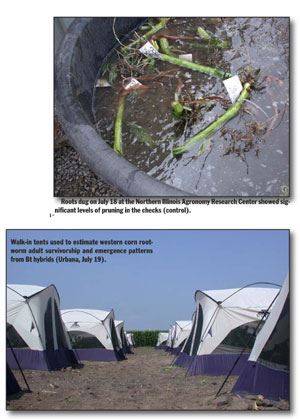Root Digs Confirm Corn Rootworm Larval Injury Greater Than Recent Seasons
URBANA, ILL.
On July 18, roots were
dug at the Northern Illinois
Agronomy Research
Center, located near Shabbona.
The roots were evaluated
the next day for injury,
and significant levels of pruning
were revealed in the
checks (control). I look forward
to sharing the preliminary
root rating results later this summer.
For anyone interested in
looking at the performance of various
Bt hybrids and soil insecticides
targeted against corn
rootworms in previous seasons,
please refer to the On Target web
site.
Although it appears that the
level of rootworm injury in our trials
is greater than in the most recent
summers (2009 and 2010),
the overall level of the western
corn rootworm population can still
be described as moderate for this
season. What will the typical corn
rootworm population look like as
we move forward in a landscape
increasingly dominated by Bt hybrids?
During the next few weeks,
our summer research team will
survey the western corn rootworm
adult population around the state
and begin to compare current densities
with data obtained
from surveys
that took place in the
1970s and 1980s.
Over time, we can
begin to make some
more informed assessments
of the current
and seemingly
changing status of
the western corn
rootworm population
in Illinois.

Roots dug on July 18 at the Northern Illinois Agronomy Research Center showed significant
levels of pruning in the checks (control).
Walk-in tents used to estimate western corn rootworm
adult survivorship and emergence patterns
from Bt hybrids (Urbana, July 19).
In addition to conducting
root injury
evaluations, our corn
rootworm research
has adapted over
time to include newer
approaches to assess
the effectiveness and
potential resilience of
Bt hybrids. Unlike Bt
hybrids that offer a high dose of Cry proteins to
many lepidopteran species (e.g., European corn
borer), Bt hybrids targeted at corn rootworm larvae
are low to moderate in their dosage. Consequently,
adult emergence from Bt fields does
take place. In an effort to better understand the
dynamics of adult emergence and survivorship
of western corn rootworm adults in a Bt seed
blend environment, large walk-in tents are often
used to estimate emergence patterns. Data from
these studies will be used by university and industry
scientists to construct mathematical
models to predict the potential longevity of new
Bt hybrids entering the marketplace that will be
sold in 95% (Bt seed) and 5% (non-Bt refuge
seed) mixtures. In my estimation, the seed mixture
blends (refuge-in-a-bag) will form the foundation
of resistance management plans for Bt
hybrids well into the future. Δ
DR. MIKE GRAY: Professor and Assistant Dean
for Agriculture and Natural Resources Extension,
University of Illinois